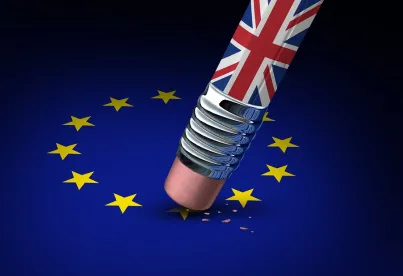The UK Parliament was prorogued (i.e. suspended) again on Tuesday 8th October, but this time inside a week as is usual before a Queen’s Speech on 14th October which set out the Government’s agenda for the coming year. It all however had a slight air of unreality about it, as most observers think that there will have to be an election in the coming months – probably before the end of the year, and the Government anyway has no majority in Parliament with which to pursue its agenda. The real question is whether the election happens this side of Brexit or the other, and if the other side, will the UK have left the EU with or without a deal. Whichever comes first will undoubtedly have a significant impact on whichever comes after. And then there’s the referendum wild card…
The prorogation and subsequent Queen’s Speech debate did allow the Government some respite from Parliamentary maneuvering during which to try to make progress on finding a way forward with the EU. A meeting between the Prime Minister and the Irish Taoiseach met on 10th October gave new impetus to negotiations with the EU resumed in earnest on 11th October.
Getting the ducks in a row…
Theresa May’s attempts to deliver Brexit foundered because she reached an agreement with the EU which a combination of those most and least enthusiastic about Brexit in the UK Parliament would not support. Boris Johnson first proposed a radically different approach, which looked to be heading to the opposite position. As a result of the meeting with the Taoiseach, however, Boris Johnson’s approach appears now to be heading towards some of the ideas which featured in Theresa May’s negotiations but were rejected then by pro-Brexit MPs including Boris Johnson.
… leading to Schrödinger’s Province?
Details of the proposal have been kept confidential. It is however clear that on leaving the EU the UK would enter into a transition period with the EU ending on 31st December 2021 (extendable to 2022). During this period, the UK would for most purposes effectively be treated as a member of the EU. This is the same as the May deal. What is different is that on 1st January 2022, there will be a new arrangement governing Northern Ireland, which would have the effect the Province would be simultaneously constitutionally within the United Kingdom and practically within the EU customs area. It would also maintain regulatory alignment between the Province and the EU Single Market. Taken together, this would ensure that – unlike the Prime Minister’s original proposal – there would be no customs border on the island of Ireland. A consent mechanism would ensure public support in Northern Ireland for this special arrangement, but without giving the representatives of either community an effective veto.
The Government is now working hard to try to ensure that there would be support for such a deal. But will they succeed? It all depends on the detail – the more Northern Ireland appears to be being put into some distinct arrangement, and the more that arrangement requires customs checks between the Great Britain and Northern Ireland, the harder it will be to keep the Northern Ireland Democratic Unionist Party and some strong Brexit supporting Conservative MPs onside.
…. in time for 31st October?
Getting to a deal in time for the UK to leave the EU on 31st October is not impossible, but time is now very short. If the eventual deal uses off-the-shelf legal language (ie. essentially lifted from Theresa May’s original negotiations), it may be possible to have a final legal text for the European Council to approve on 17-18th Oct. But if it involves new legal concepts, it is likely that the most the European Council could do would be to approve the deal outline in principle. Final approval by the European Parliament – and presumably by the UK Parliament – would have to await the final legal text. This would make an agreed UK exit from the UK by 31st all but impossible. The EU appears to believe that the risk of a “no deal” Brexit on 31st October is in practice small, not least because of the Benn Act which would require the Government, in the absence of a deal with the EU and approved by Parliament by 19th October, to seek an extension to the Article 50 deadline of 31st October. “No deal” on 31st October could still happen, if either the Government finds a way round the Benn Act (the authors do not think there is one), or if an EU Member States refuses to agree – neither of these looks likely at this point, and the latter would be even less likely in the event that there was a deal in principle already in place. There has been some speculation that the Government might request a Member State to frustrate the extension request, but it is hard to see which Member State would wish to expend political capital in causing a “no deal” Brexit – and consequent damage to the EU economy – if the other Member States wanted to agree to Johnson’s reluctant request. So leaving the EU on 31st October looks possible only if the Government can achieve the very fine balance between the EU’s requirements and what Parliament would accept, in final legally binding treaty language, and can then somehow manage to pass sufficient domestic legislation in time.
….. or later?
An extension to Article 50 when there is a deal in principle in place would be an embarrassment for the Prime Minister, given his very clear promise to have the UK out of the EU by 31st October, but it would be unlikely to do long term political harm. The election would be likely to take place after whatever became the exit date (this would politically suit both Conservative and Labour Parties better), and so be an election more about how to take the country forward after Brexit, including the shape of the future relationship with the EU, than about Brexit per se.
Any extension to the Article 50 deadline without a deal in principle would be likely to lead to a General Election before the end of the year: the only alternative would be a referendum, but there does not appear to be a Parliamentary majority for that. This could change: the Labour Party’s poor poll ratings (15 points behind the Conservatives in the weekend Opinium poll), driven in part by the Party’s equivocal position between leave and remain, make Labour MPs nervous about an early election. In practice a referendum this could not be until the early months of 2020 at the earliest, and would require new primary legislation – difficult to achieve in a Parliament in which there is no stable majority for anything – and require agreement on a suitable question. So for now, if there is no deal in principle, an election looks more likely than a referendum. From the Government’s point of view, an election in the aftermath of a “no deal” Brexit looks high risk given the uncertainties about what the practical short-term effects of a “no deal” Brexit will be. An election after a delay (which the Prime Minister swore would not happen, “do or die”) and before the new Brexit deadline also carries risk, which would probably push the Conservative Party towards more of a “no deal” position in the campaign in order to see off the threat from Nigel Farage’s Brexit Party. Previously, it was considered by many observers that the UK not leaving the EU on 31st October, and in particular Johnson requesting an extension, would be problematic for the Conservative Party. So the Prime Minister will do all he can in these circumstances to make it clear that he was forced to extend, which he has been by Parliament and may in due course be by the courts. Conservative strategists seem to think that they could turn this position to advantage in an election campaign. The alternative to signing a letter requesting extension (or having it signed on his behalf) would be for the Prime Minister to resign, but this looks unlikely both because few Prime Ministers want to stop being Prime Minister, and because the likely result of putting Jeremy Corbyn into No.10 – even temporarily would shock many core Conservative supporters. Ultimately the authors think that, in the absence of a deal in principle, the Government will ask for an extension, and that the EU will agree.
If in these circumstances the Conservative Party emerges from the ensuing election with a clear majority, then the chances of both a deal with the EU and a “no deal” Brexit would increase: the EU would be dealing for the first time with an interlocutor with both the ability to secure a Parliamentary majority in favour of whatever position emerged, and with five years in which to weather the difficulties of “no deal” before having to submit to public opinion again – in other words both the positive and negative forces pushing the parties towards a deal would be at their maximum. If that happens a majority Johnson government is likely to lead the UK towards a Canada-style relationship with the EU after transition, rather than a Norwegian, Swiss or Turkish type of relationship.
On current polling, a Labour majority looks very unlikely. So in the absence of a Conservative majority, the likelihood would be either Johnson or Corbyn heading a minority government. In these circumstances it is difficult to see the deadlock that has affected Parliament since the 2017 election changing, and the pressure to hold a further referendum would be likely to be very strong. So, in calendar order, the seemingly endless Brexit saga could come to an end through a deal being reached and ratified before 31st October, by the Conservatives winning a clear majority in an autumn election, or by a referendum next spring.





 />i
/>i
